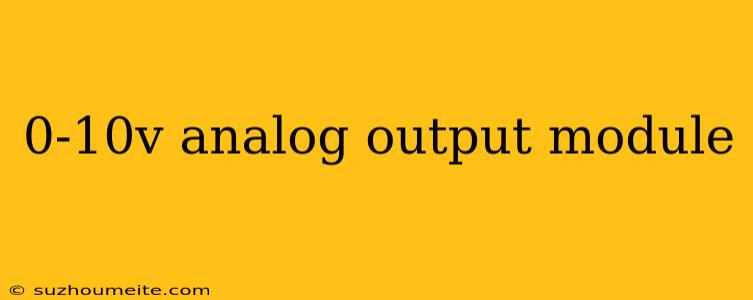0-10V Analog Output Module: Understanding its Functionality and Applications
What is a 0-10V Analog Output Module?
A 0-10V analog output module is a type of industrial control module that converts digital signals into analog output voltages ranging from 0 to 10 volts. This module is commonly used in industrial automation, process control, and measurement applications where analog signals are required to control devices or transmit data.
How does it work?
The 0-10V analog output module receives digital input signals from a controller or a computer and converts them into analog output voltages using a digital-to-analog converter (DAC). The DAC converts the digital input into a proportional analog output voltage, which is then transmitted to the connected device.
The module typically consists of a microcontroller, a DAC, and a voltage reference circuit. The microcontroller receives the digital input signal and sends it to the DAC, which converts the signal into an analog output voltage. The voltage reference circuit ensures that the output voltage is accurate and stable.
Key Features and Benefits
- High accuracy: The 0-10V analog output module provides high accuracy and stability, ensuring that the output voltage is precise and reliable.
- Flexibility: The module can be used with a wide range of devices, including actuators, valves, and sensors, making it a versatile solution for industrial automation applications.
- Ease of use: The module is easy to install and configure, requiring minimal setup and programming.
- Compact design: The module is designed to be compact and rugged, making it suitable for use in harsh industrial environments.
Applications
- Industrial automation: The 0-10V analog output module is widely used in industrial automation applications, such as controlling valves, pumps, and motors.
- Process control: The module is used in process control applications, such as controlling temperature, pressure, and flow rate.
- Measurement and instrumentation: The module is used in measurement and instrumentation applications, such as data acquisition and signal conditioning.
Advantages and Disadvantages
Advantages
- High accuracy and stability: The module provides high accuracy and stability, making it suitable for critical applications.
- Flexibility and versatility: The module can be used with a wide range of devices and applications.
Disadvantages
- Limited output range: The module has a limited output range of 0-10V, which may not be suitable for applications requiring higher or lower output voltages.
- Noise sensitivity: The module may be sensitive to noise and interference, which can affect its accuracy and stability.
Conclusion
The 0-10V analog output module is a reliable and versatile solution for industrial automation, process control, and measurement applications. Its high accuracy, flexibility, and ease of use make it a popular choice among engineers and technicians. However, its limited output range and noise sensitivity are important considerations when selecting a module for a specific application.
